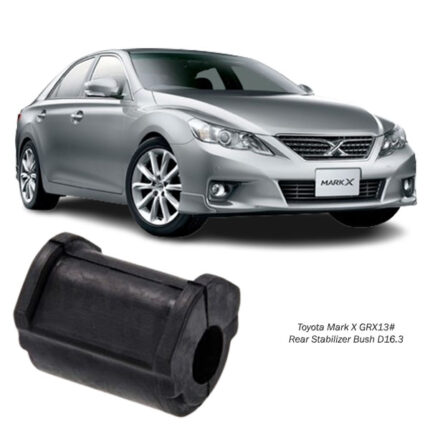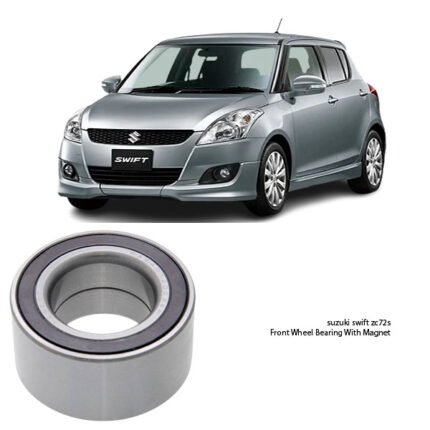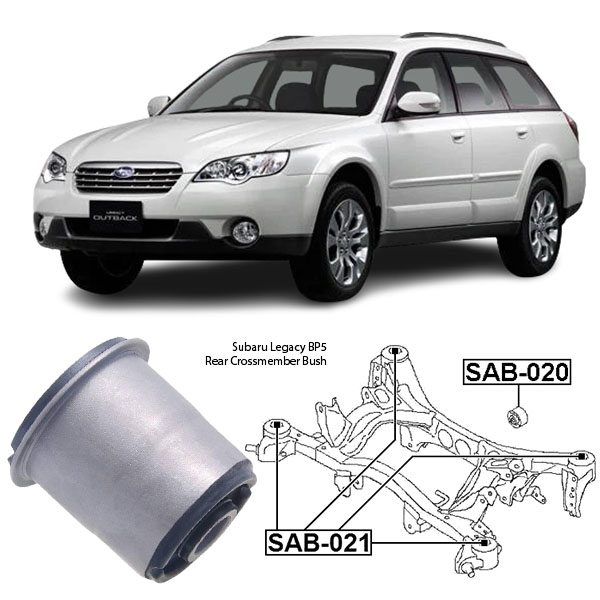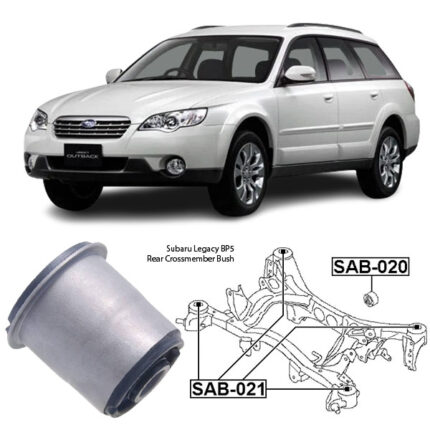Get Subaru Legacy BP5 Rear Crossmember Bush SAB-021 in Kenya
When it comes to the performance and handling of your vehicle, many of the key players operate quietly behind the scenes. One such component is the Rear Crossmember Bush — a small yet critical part of your car’s suspension system that plays a major role in how your vehicle feels, steers, and responds on the road. 🌉🔩
Though often overlooked, these bushings are essential for maintaining proper suspension alignment, reducing vibrations, and ensuring that your rear axle behaves as it should. If you’ve noticed clunking noises, uneven tire wear, or vague rear handling, your rear crossmember bush might be the culprit. Let’s explore this vital part in depth. 🧠🔍
🔧 What Is a Rear Crossmember Bush?
The rear crossmember (also known as the rear subframe) is a structural component in your vehicle’s chassis that holds the rear suspension, differential, and sometimes the exhaust system. It’s usually made of steel or aluminum and is bolted to the car body.
The bushings are rubber or polyurethane mounts that sit between the rear crossmember and the vehicle body. Their primary role is to:
-
Absorb road vibrations 🌍
-
Dampen shock loads from bumps and potholes 💥
-
Allow limited movement and flex for suspension geometry 🔁
-
Maintain proper alignment and reduce metal-on-metal contact 🛡️
These bushings act like flexible cushions that help isolate the cabin from harsh road impacts while keeping the suspension components aligned and functional.
⚙️ How It Works
When your vehicle moves, the suspension system flexes and reacts to road surface conditions. The rear crossmember supports much of that load and connects to the body through bushings. These bushings allow controlled movement of the subframe, absorbing energy that would otherwise be transferred directly into the car’s structure and cabin. 🛣️🌪️
Without these bushings, every bump, jolt, and cornering force would be harshly felt by the driver — and the components would wear out quickly due to constant stress.
🔍 Signs of a Worn Rear Crossmember Bush
Because these bushes are made from rubber or polyurethane, they degrade over time due to:
-
Constant exposure to road debris and water 🌧️
-
Heat and friction 🥵
-
Load-bearing stress, especially on uneven roads 🪨
Here are common symptoms of worn or damaged rear crossmember bushes:
-
Clunking or knocking noise from the rear over bumps or during acceleration
-
Loose or unstable rear end when cornering or changing lanes 🌀
-
Excessive vibration felt in the cabin or steering wheel 🫨
-
Uneven tire wear or rear wheel misalignment 🚫
-
Poor handling and traction, especially under load or during sharp turns
Left untreated, faulty bushings can lead to suspension misalignment, excessive wear on tires, and even damage to other components like shock absorbers and trailing arms.
✅ Benefits of Replacing Worn Rear Crossmember Bushes
Swapping out old bushings with quality replacements — especially with improved polyurethane versions — can rejuvenate your vehicle’s ride quality and stability.
1. Improved Ride Comfort
New bushings absorb vibrations more effectively, resulting in a smoother, quieter driving experience. No more rattles, bangs, or rear-end shimmies! 🛏️🚗
2. Restored Handling Precision
Worn bushes allow excessive play in the suspension, making your vehicle feel unpredictable. Replacing them tightens up the handling and restores driver confidence. ⚖️🏁
3. Better Tire Wear and Alignment
With stable suspension geometry, your rear wheels stay properly aligned — extending the life of your tires and reducing fuel consumption. 🛞💸
4. Longer Suspension Life
A firm, supportive bushing reduces strain on other components like shocks, arms, and the subframe itself. 💪🧩
🧪 Rubber vs. Polyurethane Bushes – What’s the Difference?
Rubber bushings are OEM-standard, providing excellent comfort and noise insulation. They’re great for daily driving, but wear out faster and are less resistant to heat and oil exposure.
Polyurethane bushings, on the other hand, offer:
-
Greater durability and resistance to chemicals and wear 🔥
-
Firmer handling with less flex under load 🏎️
-
Slightly increased road feel, which can mean more vibration
For performance builds or off-road setups, polyurethane is a popular upgrade. For smooth, OEM-like comfort, rubber may be the better choice. Both types serve different needs — choose based on your driving style and conditions. 🧰🛤️
🛠️ Installation and Maintenance
Replacing a rear crossmember bush requires mechanical skill and proper tools. Depending on your vehicle:
-
The rear subframe may need to be lowered or removed
-
Special tools or press equipment might be required to remove old bushes and fit new ones
-
Proper torque and alignment checks are critical afterward
It’s highly recommended that this job be done by a qualified mechanic, especially for modern vehicles with complex multi-link suspensions. 🔧👨🔧
🔄 When Should You Replace Them?
There’s no fixed mileage for bushing replacement, but on average:
-
Rubber bushings may last 80,000–120,000 km
-
Polyurethane bushings often last longer but may transmit more vibration
You should inspect or consider replacement if:
-
You hear noises from the rear
-
Your car doesn’t track straight or feels “loose”
-
You’ve recently hit a pothole or curb hard
-
You’re upgrading other suspension components
Regular suspension checks can help you catch issues early and save money in the long run. 📉🔍
🏁 Ideal for Everyday Drivers & Enthusiasts Alike
Whether you’re:
-
A daily commuter looking for a smoother ride 🚙
-
An off-roader needing durability in rough terrain 🏞️
-
A tuner wanting precise handling for performance driving 🏎️
…a high-quality rear crossmember bush will make a noticeable difference. It’s one of those parts that you only think about once it starts causing problems — but when replaced, it’s like giving your car a new lease on life. ✨🔄
🌍 Conclusion
The Rear Crossmember Bush may be small, but it’s mighty. It’s the bridge between your vehicle’s body and its rear suspension, managing forces, absorbing vibration, and keeping everything aligned and under control.
Neglecting these bushings can lead to a cascade of issues: poor handling, excess tire wear, increased noise, and compromised ride comfort. Replacing them — whether with OE-spec rubber or upgraded polyurethane — brings immediate benefits to your car’s performance and your driving experience.
So if you’re chasing comfort, control, and confidence on the road, don’t overlook the power of fresh rear crossmember bushings.
Follow us on Facebook for more parts.




